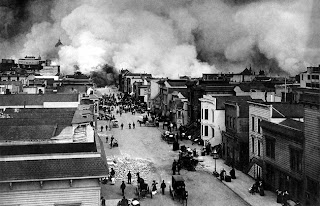


Recent severe earthquakes have occurred in the world like the ones in Haiti and Chile in 2010.
Contemporary depictions of earthquakes in films are variable in the manner in which they reflect human psychological reactions to the actual trauma that can be caused to directly afflicted families and their loved ones. Disaster mental health response research emphasizes the need to be aware of the different roles of loss of family and key community members, loss of home and familiar surroundings, loss of essential supplies and services to maintain survival. Particularly for children, the clear availability of care giving adults who are able to protect, nourish, and clothe them in the aftermath of the earthquake, and to help them make sense of what has befallen them has been shown to be even more important to their emotional and physical health than the simple giving of provisions. As was observed after other disasters involving destruction and loss of life and their media depictions, such as those of the 2001 World Trade Center Attacks or Hurricane Katrina, and has been recently observed in the 2010 Haiti and Chile Earthquakes.
An earthquake, a quake, tremor, temblor or seismic activity is the result of a sudden release of energy in the Eath´s crust that creates seismic waves. Earthquakes are measured with a seismometer; a device which also records is known as a seismograph. The moment magnitude (or the related and mostly obsolete Richter magnitude) of an earthquake is conventionally reported, with a magnitude 3 or lower earthquakes being mostly imperceptible, and magnitude 7 causing serious damage over large areas.
At the Earth´s surface, earthquakes manifest themselves by shaking and sometimes displacing the ground. When a large earthquake epicenter is located offshore, the seabed sometimes suffers sufficient displacement to cause a tsunami. The shaking in earthquakes can also trigger landslides and occasionally volcanic activity.
In its most generic sense, the word earthquake is used to describe any seismic even, whether a natural phenomenon or an event caused by humans that generates seismic waves. Earthquakes are caused mostly by rupture of geological faults, but also by volcanic activity, landslides, mine blasts, and nuclear experiments. An earthquake´s point of initial rupture is called its focus or hypocenter. The term epicenter refers to the point at ground level directly above the hypocenter.
Where plate boundaries occur within continental lithosphere, deformation is spread out over a much larger area than the plate boundary itself. In the case of the San Andreas fault continental transform, many earthquakes occur away from the plate boundary and are related to strains developed within the broader zone of deformation caused by major irregularities in the fault trace (e.g. the "Big bend" region).
Part 2 will follow...
Thanks for reading!!
Starry Dawn.



No comments:
Post a Comment